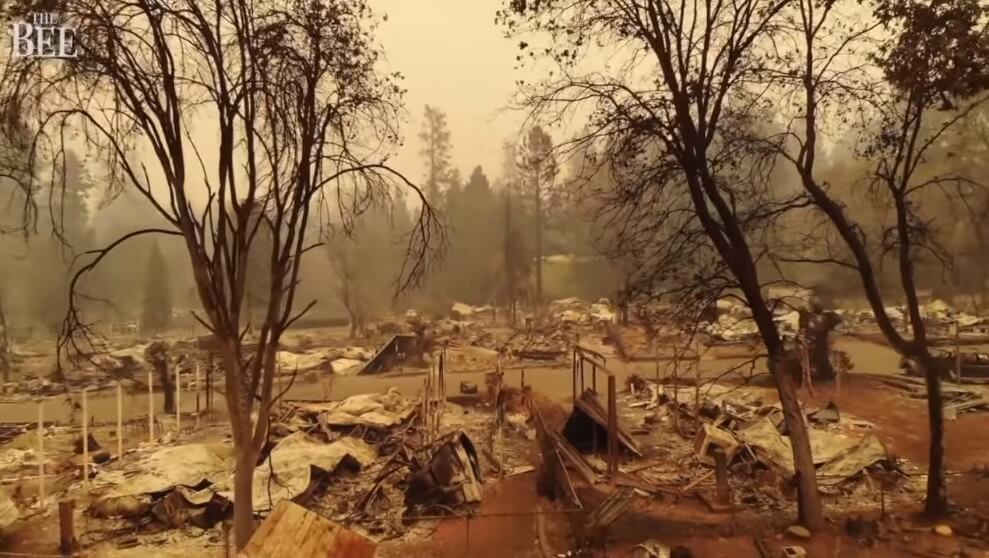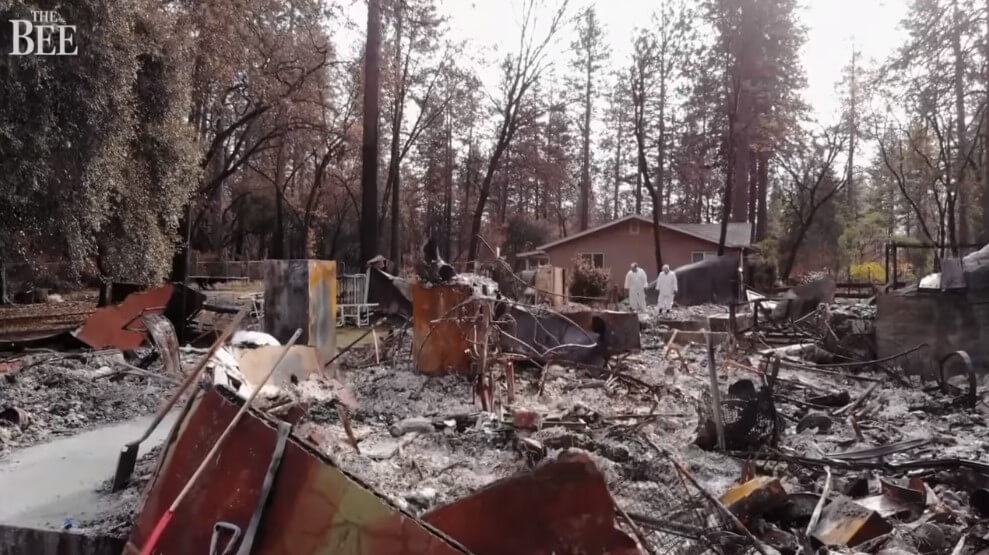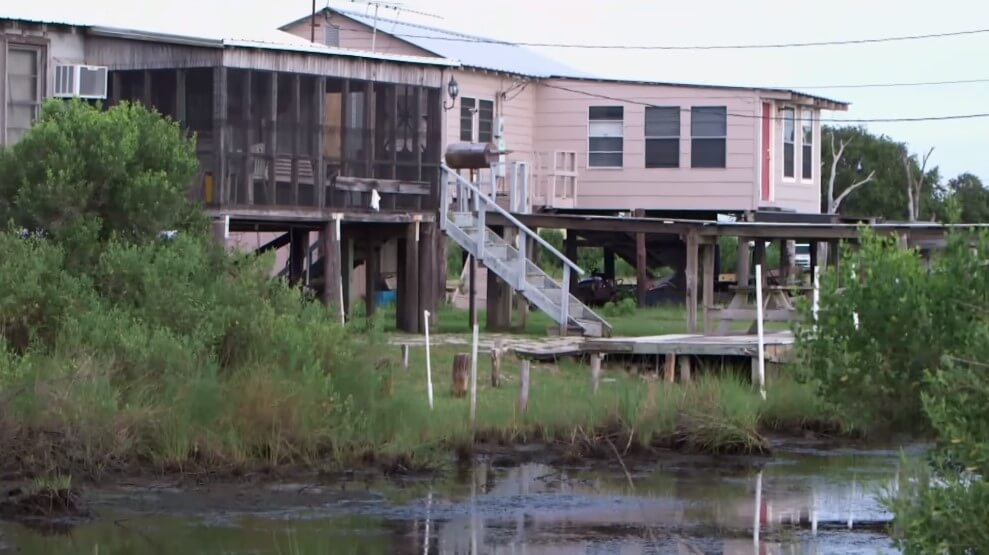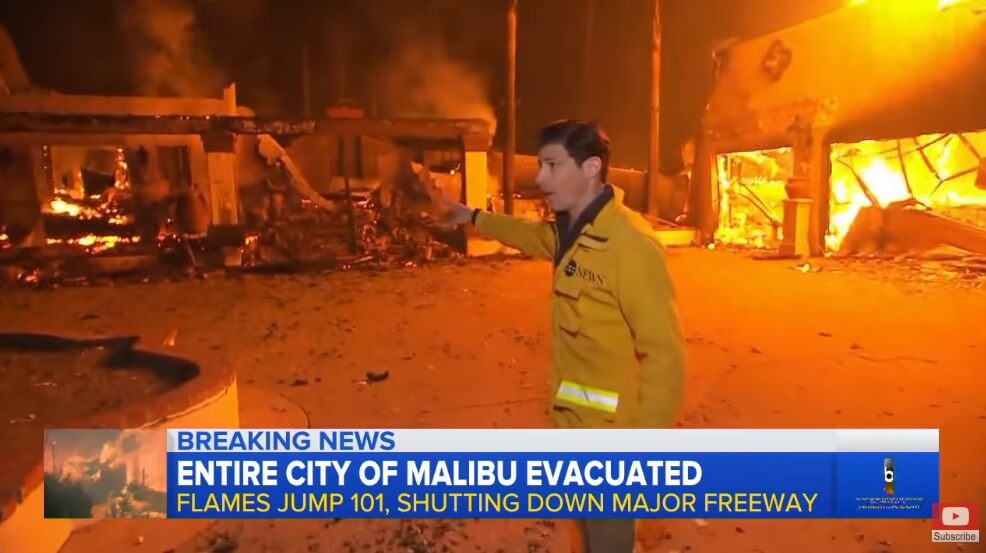"No one expected it to be so fast": how climate change is destroying US cities
Mayors of American cities need to ask a difficult question: How much longer can we live here? After the past year, which brought devastating natural disasters with human casualties to the United States, it becomes obvious that this is all very serious and is actually happening. And more often and faster than expected.

Burnt Paradise. Photo: video frame YouTube / Sacramento Bee
The deadliest, most destructive fire in the history of California in a few hours destroyed the city of Paradise with a population of 26 000 people wrote Curbed. The phrase “Paradise Lost” has become literal (Paradise - paradise translated from English - editor's note).
In November, the 2018 of the Camp Fire in Paradise burned down 95% of buildings and killed 86 people.
And this case is not the only one. Just weeks before the devastating fire, the same set of phrases (“lost,” “totally destroyed”) were used in the press to describe the aftermath of the disaster in Mexico Beach, Florida. There was one of the most powerful hurricanes in US history, which “wiped everything off the face of the earth” and killed 45 people.
In Hawaii, an 11-acre (4,45 hectare) island completely disappeared after a powerful storm hit the state. Fortunately, no one was killed, but the public reaction was the same: “No one expected that the East Island would be destroyed so quickly.”
Now it is clear what climate change really means at an accelerated pace, about which experts have spoken. Apparently, this is a fast and steady reduction in the number of places where we can build our houses, where we can come for pleasure and rest. Where, in the end, we can survive.
Environmentalist Bill McKibben described it in the New Yorker:
“The planet will have a diameter of eight thousand miles (12,8 thousand kilometers) and its surface will still cover two hundred million square miles (518 million square kilometers),” he writes. “But the Earth for people began to shrink under our feet and in our minds.”

Burnt Paradise. Photo: video frame YouTube / Sacramento Bee
Climate change is already starting to take away our cities, much earlier and rougher than we expected. In 2019, we no longer have to decide where we want to live. The question is, how long can we live there?
On the subject: Fighting climate change: California restaurants will increase prices
When the Intergovernmental Panel on Climate Change released its grim Game Changer report in October 2018, it said we would see the most devastating effects of climate change in decades, not generations. Just a month later, the National Climate Assessment, a report from 300 experts and 13 US government agencies, brought the looming threat into sharp, local focus for Americans with clear guidance for the future.
The climate assessment is broken down by regions where the U.S. population will be exposed to the most dangerous climate impacts, such as storms, severe flooding or wildfires. The report warns that unless American city leaders take action to adapt to these risks, cities will face "dire consequences."
Most importantly, cities should make these changes before, not after, a disaster, the report notes. It also emphasizes that many cities' adaptation actions "emerge and are funded in the context of recovery after an event, rather than being undertaken in advance." It is recommended to change the approach to land use - in particular, to abandon construction in high-risk areas, and also to attend to the preparation of full-fledged shelters.
There is now an urgent need to reduce emissions: in a year, more than 455 US cities have joined an initiative organized by mayors (the Covenant of Mayors on Climate Change) that is trying to make fundamental changes in the approach to this issue.
But if mayors agree that climate change threatens cities, then they must consider the fact that some cities (and often their cities) must be completely relocated to cope with climate change. Or the changes will affect them first.
The first US climate refugees from the island of Jean de Charles (Louisiana) and Shishmaref (Alaska) did not wait for their disaster to wipe their homes off the ground. They move slowly and purposefully before the dwellings disappear from the map after the disaster.

Isle Jean de Charles, Louisiana, leaving under water. Photo: video frame YouTube / PBS NewsHour
That is how you need to think more cities. In the next decades, the migration patterns of the United States will be almost exclusively determined by people who orderly retreat from the already known threat, as well as those who have become homeless due to a fatal disaster, and people who cannot continue to earn a living in an empty city. A combination of all three factors is possible.
On the subject: Americans warned: 12 years left before dangerous climate change
In addition to almost 3000 Americans who died in Puerto Rico after Hurricane Maria due to the complete inability to receive basic services, at least 135 000 people left the island and did not return.
In the future, those who can afford it will leave from the intense heat of Phoenix or the chronic flooding of South Beach. They will engage in conversations about where to move to avoid the worst effects of climate change (probably in Chicago). Others will try to stay in cities for as long as possible and build spare houses as a security measure.
There's a scene in the 2018 National Geographic documentary From Paris to Pittsburgh that shows cities taking action after the U.S. pulls out of the Paris Agreement. In the shot, University of Miami geoscientist Harold Wanless sits on a boat in the Everglades with Chris Castro, director of sustainability for the city of Orlando.
A Florida freshwater source mixes quickly with salt water due to rising sea levels, and, according to Wonless, Miami will become uninhabitable for a century.
“We're really just getting ready to leave in South Florida,” Wanless Castro says. - We don't have a problem. You in Orlando better stock up on groundwater resources, and you better plan how to host us. You better plan it because we’re coming… We’re coming.”
More than 1 of 10 homes in California are located in areas of greatest fire risk. Over 20 000 homes and businesses across the country can be permanently under water by 2045.
However, federal, state, or local governments are not making concerted efforts to prevent people from building more houses in these places. And even less effort is being made to work with neighboring cities, which will have to accept these new residents after catastrophic losses.
Mayors say they are on the side of climate change. However, if (when!) a climate disaster occurs, mayors will publicly declare that everything will be restored and ignore criticism that they should have prepared in advance.
For example, the city of Malibu is one of the 455 cities that have joined the climate initiative and committed themselves to “demonstrate leadership on climate change through meaningful action.”

Fire in Malibu in November 2018. Photo: video frame YouTube / ABC News
But in December, Malibu Mayor Rick Mullen, who is also the captain of the Los Angeles County Fire Department, said that his priority after the fire would be to restore 400 destroyed houses as soon as possible, and not to create a more fire-resistant and climate-resistant settlement.
Since Democrats regained control of the House during the midterm elections, many new congressional leaders have made the Green New Deal a central part of their platforms. This “course” would encourage Americans to work in industries that can significantly reduce emissions and build infrastructure to mitigate the inevitable consequences.
After last year there is no doubt that the joint work of cities can have a huge impact on the situation. Carbon emissions have already peaked in 27 cities around the world. 2018 ended the year with news that emissions around the world, including the United States, have actually increased.
Commitment to climate goals has become a powerful symbol of unity. But we need more tough decisions. As a society, Americans need to focus on rapidly rebuilding cities in order to create an opportunity to coexist with the effects of climate change.
Read also on ForumDaily:
Hawaii has become dangerous to rest due to a deadly infection
By the year 2100 New York could go under water
Good weather and low unemployment: the top 10 of the fastest growing US cities
Subscribe to ForumDaily on Google NewsDo you want more important and interesting news about life in the USA and immigration to America? — support us donate! Also subscribe to our page Facebook. Select the “Priority in display” option and read us first. Also, don't forget to subscribe to our РєР ° РЅР ° Р »РІ Telegram and Instagram- there is a lot of interesting things there. And join thousands of readers ForumDaily New York — there you will find a lot of interesting and positive information about life in the metropolis.











